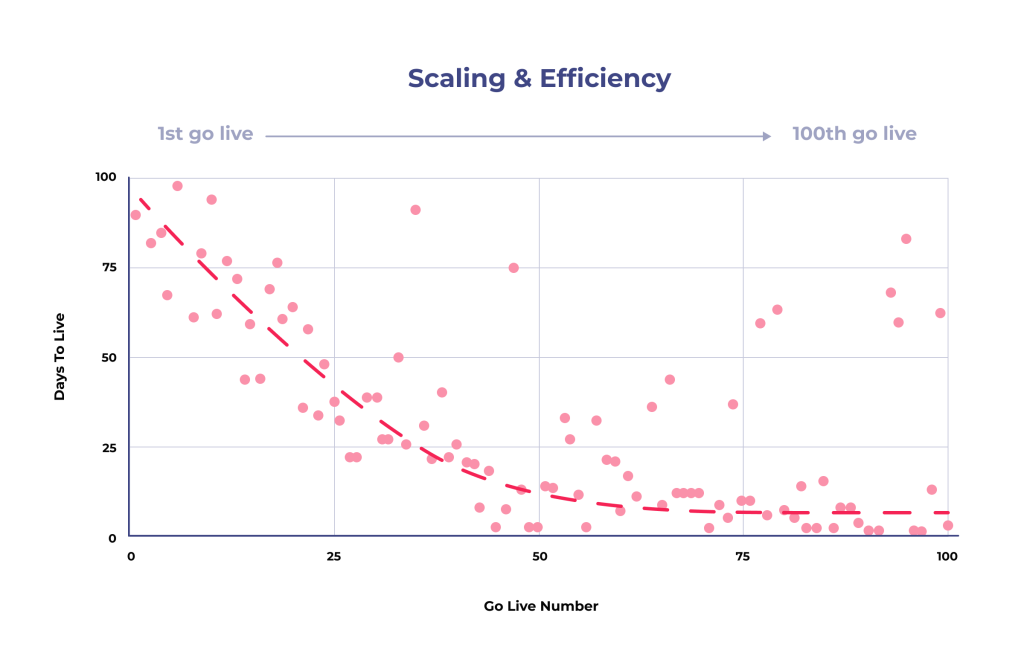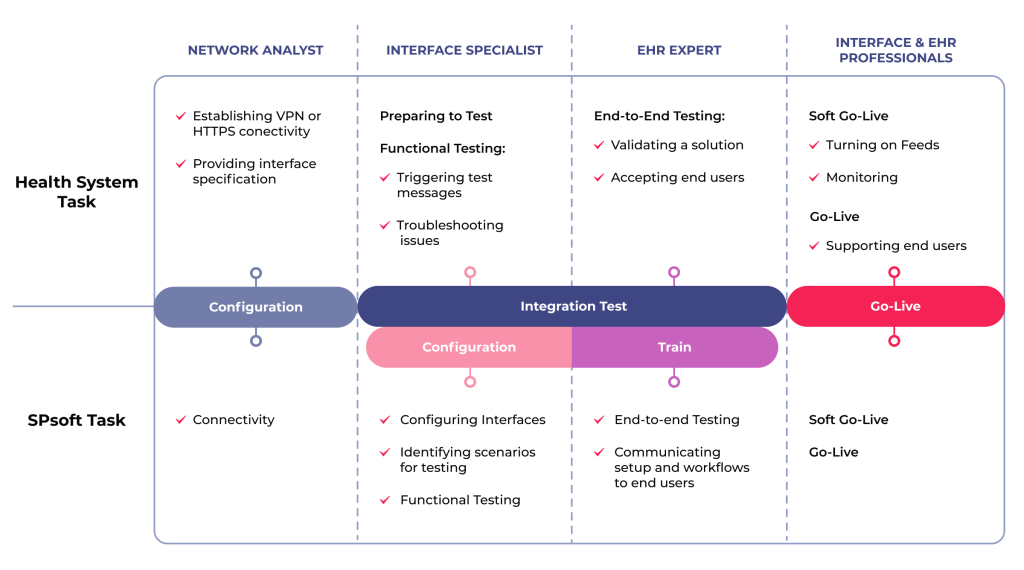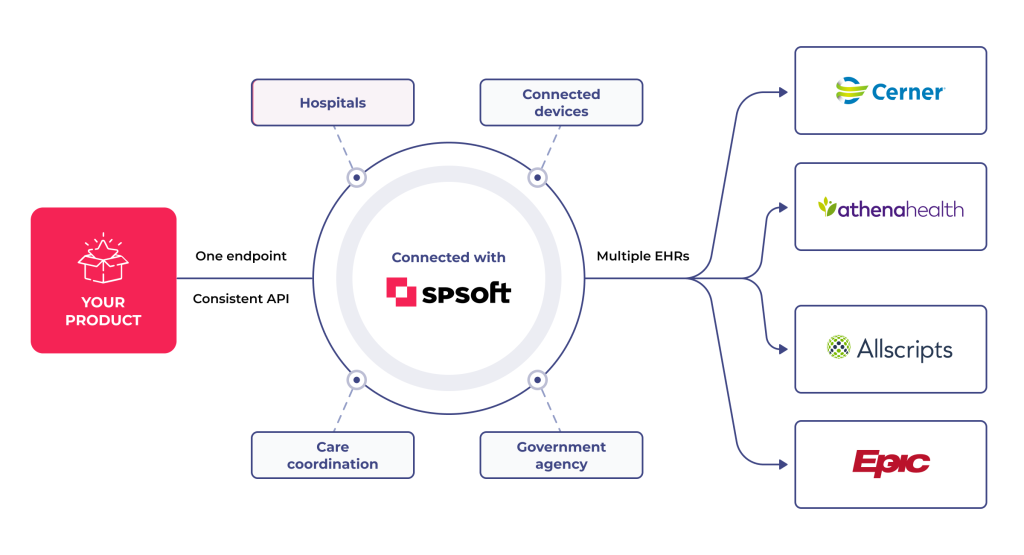When engaging with a health system for sales or collaboration, clearly articulating the strategy and resources needed for healthcare integrations is essential. Research from HIMSS in 2021 highlights that incompatibility between EHR and enterprise systems is the primary or secondary challenge by health systems when evaluating third-party solutions.

This article aims to guide sales teams on how to proficiently present healthcare integrations within their sales approach and establish realistic expectations for a fruitful integration project.
Table of Contents
“At SPsoft, our dedication to revolutionizing healthcare integrations reflects our deep understanding of the ecosystem’s complexities. We enhance patient care and set new industry standards by prioritizing seamless, secure connections with health systems. Our approach is not about overcoming challenges but transforming them into opportunities for innovation and growth, ensuring our partners are always at the forefront of healthcare technology.”
Mike Lazor
CEO, SPsoft
“Our team at SPsoft is at the cutting edge of integrating healthcare systems, leveraging our expertise to create solutions that are as innovative as they are effective. We understand the critical nature of these healthcare integrations and are committed to providing our partners with the tools they need to deliver exceptional patient care. Through collaboration and technical excellence, we’re making healthcare more accessible, reliable, and secure.”
Romaniya Mykyta
Head of Product Management, SPsoft
3 Crucial Tips to Pitch Healthcare Integrations Efficiently
You have built an exceptional product and are eager to introduce it to health systems, but what strategies can ensure you attract the proper interest? Addressing critical questions can mean distinguishing between being overlooked and securing the deal.
Understand the Project Scope
When engaging with a health system, you must be ready to clarify, “What will be the time and effort required from my team for this implementation?” Health systems may perceive adopting a new application as a more significant endeavor than it is, often due to misunderstandings about the actual costs and efforts involved in implementation.
Predicting the exact duration for project completion is challenging due to various influencing factors. However, collaborating with a healthcare integrations specialist like SPsoft can help accelerate the realization of value for your clients while minimizing the demand on the system’s IT department. You should emphasize this advantage, assuring that your project stands out as an exception. Meanwhile, leveraging the strategies below in your product’s marketing and sales efforts is vital.
Strategy 1. Promote the pros of your product alongside your healthcare integration approach
Traditional thinking may have suggested to sales teams that healthcare integrations considerations come later. Yet, the HIMSS research reveals that 84% of respondents identified the ability to integrate with their EHR as the primary factor in their decision to explore third-party tools and techs.
Increasingly, health systems are adopting a strategy emphasizing product integration, aiming for greater ROI and a quicker realization of value. Therefore, making your integration plan a central topic of discussion during sales is crucial.
Strategy 2. Implement a read-only scope of healthcare integrations at the beginning
Focus on healthcare integration requirements that necessitate the health system only to transmit data to your application. That is because this approach generally demands less time and causes less stress for the health system. It guarantees that you do not disrupt end-user workflows and minimizes the need for configuration adjustments from the health system’s perspective.
Enhance your healthcare practices with EHR software integration that sets the standard for interoperability. Contact us and transform your EHR capabilities!
Embrace the Art of Compromise
Integration endeavors often require compromise, adaptability, and diplomatic skills to forge a consensus that satisfies all parties. Consider, for instance, the goal of automatically registering patients in your database while simultaneously updating EHRs with specific data. That can involve leveraging a Patient Demographics feed, which could entail a two-step process:
- Deprive end-users of the need to enter patient data into multiple systems
- Facilitate the return of data to the EHR for further utilization
IT departments may indicate that while the first step is achievable, the second presents great challenges. An alternative solution is to accept a PDF report containing valuable information for the EHR. By remaining open and adaptable to the health system’s capabilities, you enhance the likelihood of your product’s acceptance.

Strategically Outline Your Healthcare Integrations Approach
Securing the interest of a health system in your product is just the beginning. The next step is to communicate your vision for healthcare integrations. But remember that organizations may require different levels of detail in the integration plan, from complex project outlines to a simple assurance of feasibility. Thus, to cover all bases, you should prepare for both scenarios.
Discussing the Project in Detail
This section dives deeper into several essential aspects regarding the potential healthcare integrations, such as major players, connection time, and project timelines.
Main Stakeholders
For effective coordination and clarity throughout the integration project, establishing and understanding the roles of all parties is a must. Below is an illustrative, though not exhaustive, list of roles typically filled by health system employees and other contributors. All of them will significantly bring the project to fruition.
- Project Advocate. Offers insights into the rationale behind app deployment and makes critical purchasing decisions. Besides, they serve as a point of contact when escalating project-related issues. Their titles might range from Chief Medical Information Officer (CMIO) and Chief Technology Officer (CTO) to department head or chief.
- IT Lead. Acts as the first contact for the IT department, addressing and managing project concerns.
- Network Analyst. Provides Virtual Private Network (VPN) connectivity support and resolves related challenges.
- Interface Specialist. Responsible for setting up and configuring the interface to facilitate message exchange and conducting test transmissions.
- EHR Expert. Performs updates to EHRs if necessary and aids in testing workflows.
- Application Lead. Oversees project management at the application level, including the completion of development tasks, and spearheads the discovery of workflow processes.
- SPsoft Team. Comprises different members contributing to the project’s advancement, featuring healthcare integrations specialists and healthcare data experts.
These roles form the backbone of the project team, ensuring a collaborative effort towards successful healthcare integrations.
Unravel the complexities of EHR implementation in healthcare with our in-depth exploration of navigating costs and technological challenges!
Estimating Connection Time
The initiation phase for connecting with SPsoft typically culminates in a go-live event occurring roughly 10-14 weeks post-kickoff. However, you must understand that this estimated timeframe can vary based on numerous factors. That may include the readiness and engagement level of the health system partner and the complexity of the healthcare integration project.

Insights from the HIMSS research indicate that a 4-6 months deployment period for integrating a new technology system with the respondents’ EHR system is acceptable by over 50% of them. The good news is that the anticipated time frame for SPsoft implementations can align with or surpass the expectations of health systems. After all, as you expand your collaboration with us as your healthcare integrations partner, your ability to rapidly deliver value to your clients will also increase.
Project Timelines
The process starts with a kickoff meeting when initiating a healthcare integration effort with SPsoft. This crucial gathering should include representatives from the health-tech company, the health system, the EHR provider (if applicable), and SPsoft. Its purpose is to collectively review and refine the integration strategy formulated in partnership.
Meanwhile, the agenda will specifically cover the utilization of existing health system feeds and the detailed plan for achieving healthcare integrations. Such a meeting also offers an opportunity to address any concerns related to security, compliance, or operational procedures.
You should know that our estimated timeline for project completion is subject to various external influences. They may involve the health system’s project prioritization, the availability of desired interfaces, and the complexity of your specific application.

The diagram above provides:
- A comprehensive overview of the critical integration milestones.
- Shared responsibilities between SPsoft and the health system team.
That covers everything from the initial kickoff and connectivity stages, culminating in the project’s go-live phase.
Revolutionizing Healthcare Integrations with SPsoft
During discussions with health systems, your sales reps may indicate your integration partner. Also, there might be a request for an in-depth exploration of your healthcare integration strategy. While not all health systems require extensive details about the process, ensuring the integration partner adheres to stringent security measures is a priority.
Fortunately, SPsoft stands out through a unique value proposition in the interoperability arena. Your sales team can leverage it to clarify the integration process and demonstrate how your product integration strategy becomes more efficient and streamlined with our support. This narrative is beneficial in discussions with health systems and when engaging investors, internal teams, or prospective partners.

Streamlining Integration with a Modern API
SPsoft’s platform revolutionizes integration by moving away from traditional point-to-point connections. Our top-notch API offers a unified standard and connection for your application, requiring a single setup.
This approach simplifies the integration process, eliminating the need to adjust documentation delivery methods across various EHR systems like Cerner and Epic. By coding once to our platform, you bypass the need to install enterprise software or develop bespoke interfaces. That enhances scalability and efficiency as your product grows.
Navigate the future of healthcare with confidence by mastering EHR API integration. Read our informative guide to understand the ins and outs of the process!
Accelerating Growth
Your product’s integration with SPsoft brings seamless connectivity with multiple EHR systems. As you expand, our in-depth understanding of your application’s specifics allows for quicker implementation in subsequent projects. When integrating with health systems already in our network, the tech groundwork previously laid out facilitates a near-instantaneous go-live for your product. SPsoft’s platform fosters easier data exchange by optimizing current infrastructure, distinguishing it from labor-intensive point-to-point connections.
Managed Services for Hassle-Free Integration
With SPsoft, the burden of building and maintaining connections to customer EHR systems is lifted. Our comprehensive managed services eliminate the complexities of VPNs, SFTP, and other technical challenges, sparing your team from becoming network security experts. This approach simplifies connectivity and reduces the resource allocation necessary from your side.
Maximizing Health System IT Efficiency
Compared to traditional point-to-point interfaces, our healthcare integration model simplifies the workload for health system IT departments. They can save substantial time and effort without intricate message manipulation or configuration updates. On average, our project demands considerably fewer IT resources, complemented by our proactive monitoring and alerts. That ensures secure and reliable connections.
Adapting to Industry Evolutions
SPsoft’s leading API is designed to accommodate the dynamic nature of the healthcare industry, including EHR updates, system changes, or new data standards like FHIR. Our hub-and-spoke architecture and SaaS model provide the agility to make adjustments swiftly. That guarantees your application remains integrated and supported over the long term.
Choosing between a FHIR Façade and a FHIR Repository can be pivotal for your business. Discover which option aligns best with your needs in our comparison!
Positioning Your App as a Lightweight, Turnkey Solution
In an environment where health systems are approached by many applications for integration, offering a solution that demands minimal effort and maintenance from the health system makes your product highly attractive. Partnering with SPsoft positions your application as an almost immediate fit, streamlining the path to healthcare integrations and enhancing its appeal to health systems.
Thus, by choosing SPsoft, you will obtain a strategic collaboration that enhances your product’s appeal in a competitive market, promising efficiency and ease of integration to health systems.
Final Thoughts
This guide aims to equip you with a robust understanding of integration processes and relevant strategies for effectively marketing your product to health systems. By delving into it, you should possess the vital knowledge to navigate the complexities of integration, tailor your pitch to meet the specific needs of health systems and execute projects confidently. Ultimately, that will lead to successful partnerships and product implementations.
Ready to bridge the gap in healthcare interoperability? SPsoft is your partner in seamlessly integrating health systems, enhancing data fluidity, and optimizing care!



